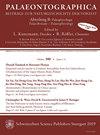Middle Jurassic – earliest Late Cretaceous palynofloras, coastal Tanzania - Part One
IF 1.6
3区 地球科学
Q2 Earth and Planetary Sciences
Palaeontographica Abteilung B-Palaeophytologie Palaeobotany-Palaeophytology
Pub Date : 2011-11-11
DOI:10.1127/PALB/286/2011/101
引用次数: 10
Abstract
This Part Two of the current monograph (Msaky 2011) completes the systematic palaeontology and discusses the biostratigraphic and palaeogeographic significance of the palynofloras together with the results of palynofacies analyses. In the systematic section, two new species are established: Pseudoceratium redactum and Sentusidinium tanzaniensis. Six informal, stratigraphically successive, dinoflagellate assemblages are distinguished, as follows: Assemblage I (Bajocian–Bathonian); Assemblage II (Callovian); Assemblage III (Oxfordian); Assemblage IV (Kimmeridgian–Tithonian); Assemblage V (Berriasian–Barremian); and Assemblage VI (Aptian–Cenomanian). Coastal Tanzania appears referable to the Austral dinoflagellate realm due to the presence of, inter alia, Broomea ramosa, Komewuia glabra, Wanaea clathrata, and Wanaea digitata. Some minor biostratigraphic anomalies are noted, including the introduction of Glossodinium dimorphum; this is datable as early Oxfordian in Tanzania whereas in Australasia the species appears earlier (in the Callovian). A few noteworthy quantitative phenomena are evident; for instance, the abundance of Lithodinia jurassica in the vicinity of the Callovian–Oxfordian boundary and the marked increase of Wanaea spp. in the Oxfordian, specifically in the Ruvu Basin of the northern coastal belt. These events are of chronostratigraphic significance and could be applicable to regional correlation. Middle– Late Jurassic assemblages show a conspicuous degree of cosmopolitanism, and include some species previously considered to be restricted to certain regions in the low and high latitudes. The Early Cretaceous (Berriasian–Barremian) assemblages show close affinity to the Tethyan Realm. The latest Early Cretaceous (Albian) to earliest Late Cretaceous (Cenomanian) strata are allied to the Albian–Cenomanian Elaterates province. The presence of elater-bearing pollen in offshore and onshore sections of Tanzania indicates that the Elaterates had a wider geographic distribution than previously reported: i.e., extending beyond the northern part of the African and South American continents. The lower part of the Kipatimu Formation, which contains Assemblage IV, yielded Komewuia glabra, Broomea ramosa, and Rigaudella aemula and their presence precludes the Early Cretaceous age previously ascribed to this part of the formation. Likewise the Makonde and Mikindani Beds have yielded typically Early Cretaceous pollen grains including Classopollis braziliensis, Retitricol pites vulgaris, and Elaterocolpites castelainii. The Jurassic/Cretaceous boundary is coincident with the upper limit of Assemblage IV, based on the last appearances of, in particular, Komewuia glabra and Rigaudella aemula. Within the Kipatimu Formation (as represented in wells SS-5 and SS-7), the systemic boundary appears conformable. But elsewhere in the coastal belt, the boundary is clearly unconformable. On the basis of palynostratigraphic data, significant biostratigraphic events, such as introductions and exits of certain dinoflagellate species commonly match sequence boundaries. From palynofacies analyses and palynostratigraphic data, the Kipatimu Formation is dominated by phytoclasts indicating high terrestrial inputs during its deposition. Abundance of black wood (of high buoyancy) in the majority of samples implies high energy settings and abundance of brown wood (less buoyant) is an indication of a sudden terrestrial input into the marine system. The organic composition of sedimentary rocks is an important means whereby the depositional history of the enclosing sediments can be understood. Different environmental settings clearly influence the character of palynofacies. For example, abundant Author’s address: Dr. Emma S. Msaky, Tanzania Petroleum Development Corporation, BWM Tower A, Azikiwe/Jamhuri strees, P.O.Box 2774, Dar Es Salaam, United Republic of Tanzania. E-mail: emma.msaky@uqconnect.edu.au, emmalekei@yahoo.com (c) 2015 www.schweizerbart.com DOI:10.1127/palb/286/2011/101中侏罗世-最早的晚白垩世孢粉植物,坦桑尼亚沿海-第一部分
本专著的第二部分(Msaky 2011)完成了系统的古生物学研究,并结合孢粉相分析结果讨论了孢粉植物的生物地层学和古地理意义。在系统部分,建立了两个新种:Pseudoceratium reactum和Sentusidinium tanzaniensis。六个非正式的、地层上连续的鞭毛藻组合被区分如下:组合I(巴若夏-巴统);集合II (Callovian);汇编III(牛津语);第四组合(基默里吉亚-梯索尼亚);组合V (Berriasian-Barremian);和汇编VI (Aptian-Cenomanian)。坦桑尼亚沿海地区似乎可指南鞭毛纲,因为存在,除其他外,Broomea ramosa, Komewuia glabra, Wanaea clathrata和Wanaea digitata。注意到一些小的生物地层异常,包括引入Glossodinium dimorphum;这一物种在坦桑尼亚可以追溯到牛津早期,而在澳大拉西亚则出现得更早(在Callovian)。一些值得注意的定量现象是显而易见的;例如,嘉洛纪-牛津纪界线附近侏罗纪石岩属丰富,牛津纪Wanaea属明显增加,特别是在北部沿海带的Ruvu盆地。这些事件具有年代地层意义,可用于区域对比。中-晚侏罗世组合显示出明显的世界主义程度,包括一些以前被认为局限于低纬度和高纬度某些地区的物种。早白垩世(贝里亚-巴雷米亚)组合与特提斯王国密切相关。早白垩世晚期(Albian)至晚白垩世早期(Cenomanian)地层与Albian - Cenomanian Elaterates省有关。在坦桑尼亚的近海和陆上部分发现的带晚装花粉表明,晚装花粉的地理分布比以前报道的更广泛:即,延伸到非洲和南美洲大陆的北部以外。Kipatimu组下部包含组合IV,产有Komewuia glabra、Broomea ramosa和Rigaudella aemula,它们的存在排除了之前认为属于这部分地层的早白垩纪时代。同样,Makonde和Mikindani地层也发现了典型的早白垩世花粉粒,包括Classopollis braziliensis、Retitricol - pites vulgaris和Elaterocolpites castelainii。根据最近出现的Komewuia glabra和Rigaudella aemula,侏罗纪/白垩纪界线与组合IV的上限一致。在Kipatimu组内(如SS-5和SS-7井所示),系统边界表现为整合。但在海岸带的其他地方,边界显然是不整合的。根据孢粉地层资料,重要的生物地层事件,如某些鞭毛类物种的引入和退出,通常与层序边界相匹配。从孢粉相分析和孢粉地层资料来看,Kipatimu组以植物碎屑为主,表明其沉积时期陆源输入较大。大多数样本中大量的黑木(浮力大)意味着高能量环境,而大量的褐木(浮力小)表明突然有陆地输入到海洋系统。沉积岩的有机组成是了解其外围沉积物沉积历史的重要手段。不同的环境背景对孢粉岩相特征有明显的影响。作者地址:坦桑尼亚联合共和国达累斯萨拉姆Azikiwe/Jamhuri街道BWM塔A号邮编2774信箱坦桑尼亚石油开发公司Emma S. Msaky博士。E-mail: emma.msaky@uqconnect.edu.au, emmalekei@yahoo.com (c) 2015 www.schweizerbart.com DOI:10.1127/palb/286/2011/101
本文章由计算机程序翻译,如有差异,请以英文原文为准。
求助全文
约1分钟内获得全文
求助全文
来源期刊
CiteScore
3.90
自引率
0.00%
发文量
1
审稿时长
>12 weeks
期刊介绍:
Section B of Palaeontographica publishes contributions to palaeobotany, i.e. papers on morphological traits, systematics and phylogenetic features of plants as well as papers on palaeoclimatology and palynogeography. Especially worth mentioning are the comprehensive monographs published in Palaeontographica B on specific floras or plant groups. Often palaeoclimatic or stratigraphic problems are clarified by resorting to palaeobotanical data published in Section B of Palaeontographica.
Throughout the last decades, numerous objects important to palaeophytology have been found in many places all over the world. As Palaeontographica publishes papers on floras on any parts of the world to report world-wide research, contributions in German, English and French have been published since the beginning of the journal, today English language publications are preferred.
Palaeontographica B is of interest to palaeobotanists, palynologists, palaeoclimatologists, stratigraphers and the libraries of all institutions engaging in such research.

 求助内容:
求助内容: 应助结果提醒方式:
应助结果提醒方式:


